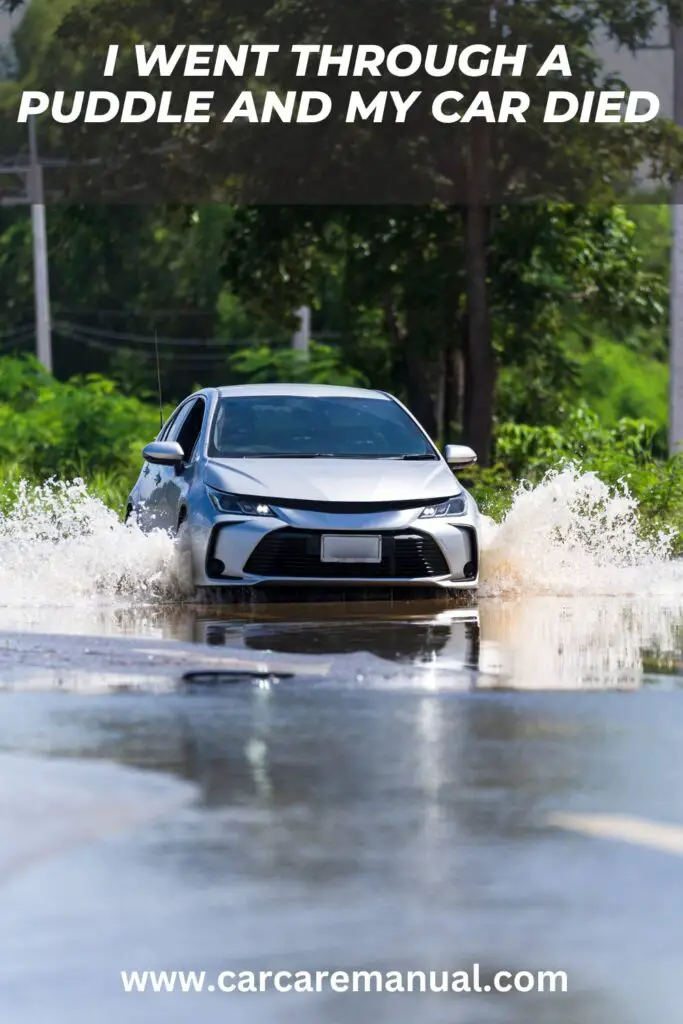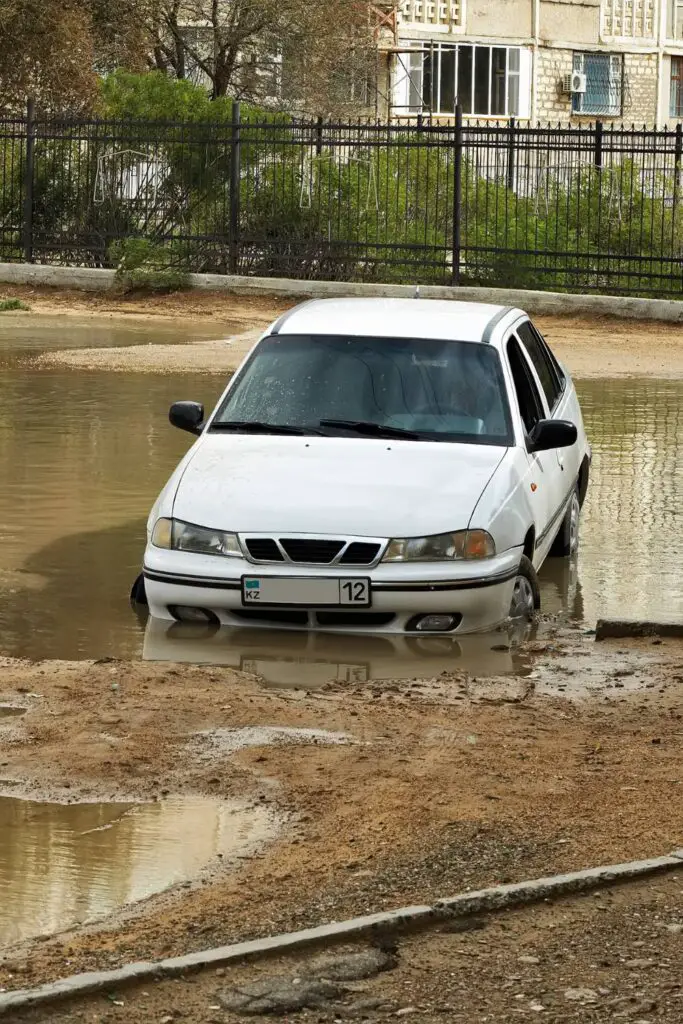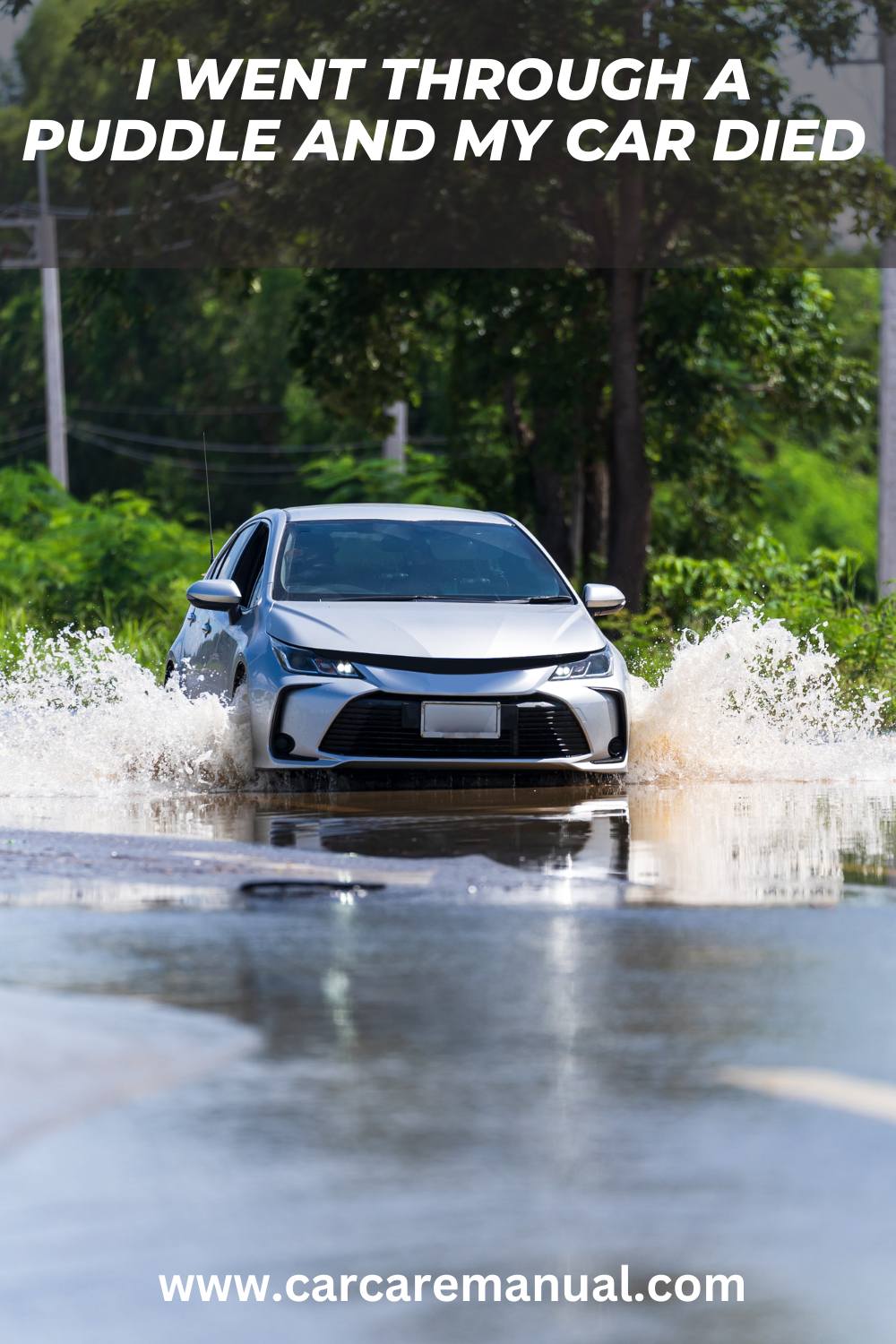Last Updated on August 31, 2023 by Henry T. Hawkins
Driving through deep water can be a very dangerous situation and if done incorrectly, it can cause your car to die. If you have gone through a puddle and your car has stopped working, you’ll want to know what to do next. In this article, we’ll explore the steps you should take if you’ve gone through a puddle and your car has died.

I went through a puddle and my car died – What to do now?
If you’ve gone through a puddle and your car has died, the first thing you should do is to assess the situation. Take a good look at the water, and think about how deep it is. If the water is deeper than a few inches, there’s a good chance that it has gotten into your engine, which can cause a lot of damage.
You should also check to see if there is any visible water in the engine compartment. If there is, it’s likely that the water has gotten into the engine.
Once you’ve assessed the situation, the next step is to try to start the car. If the engine won’t start, it’s likely that the water has caused significant damage to the engine. In this case, you should have the car towed to a mechanic for further inspection.
If the engine does start, but the car stalls shortly after, this could indicate that the water has damaged the electrical system. In this case, you should still have the car towed to a mechanic for further inspection.
It’s also important to remember that water can cause damage to other parts of the car as well. For example, if the water was deep enough, it may have reached your brakes, suspension, or other vital components. As such, it’s important to have a comprehensive inspection done on your car by a qualified mechanic.
If your car has been damaged due to going through a puddle, it’s important to take the necessary steps to get it fixed. According to mechanic, Terry Jones, “If your car has been damaged due to going through a puddle, it’s important to take it to a professional. A professional mechanic will be able to best assess the damage and provide you with the best course of action.”
It’s also important to remember that water can cause corrosion to the electrical components of your car. This can lead to further damage, and even cause your car to catch fire. According to mechanic, Tim Miller, “It’s important to remember that water can cause corrosion to the electrical components of your car. This can lead to further damage, and even cause your car to catch fire. It’s important to have the electrical system of your car checked by a professional to ensure that it is in good condition.”
Once your car has been inspected and fixed by a professional, it’s important to be aware of the risks associated with driving through deep puddles. According to mechanic, Shayne Spurling, “One should always be careful when driving through deep puddles. If the water is deeper than a few inches, it could cause significant damage to your car. It’s important to err on the side of caution and avoid driving through deep water.”
What Happens if Water Gets in Your Car’s Engine?
When water enters a car’s engine, it can lead to a series of serious problems. If water enters the engine cylinders, it can get compressed by the pistons, causing a condition known as hydrolocking. Hydrolocking can cause significant damage to the engine components, including bending piston rods or even cracking the engine block or cylinder head.
Moreover, water in the engine can lead to compression issues as the water has no place to go and remains trapped in the engine. This can eventually lead to the failure of your piston, leading to severe engine damage.
Furthermore, water getting into your engine can also lead to rusting of the internal parts. Rust can cause the metal parts of the engine to deteriorate, which could result in a loss of engine performance or total engine failure over time.
Even a small amount of water can cause problems. If a minor amount of water enters the cylinder, it might disappear during the combustion cycle and get expelled out with the exhaust gases. However, if a larger amount of water gets into the engine, it could lead to significant engine damage.
How to Tell if You’ve Got Water in Your Engine?
Detecting water in your car’s engine involves several steps, and it’s crucial to act promptly to prevent severe damage. Here are some of the ways you can tell if there is water in your engine:
Check the Engine Oil:
Pull out the engine oil dipstick and observe the oil’s color and consistency. If the oil appears milky or diluted, or it’s no longer its original color, there’s a high chance that there’s water in your engine.
Inspect the Transmission Fluid:
Similarly, check the transmission fluid. Water contamination can also cause the fluid to become milky or discolored.
Examine the Air Filter and Intake:
If these parts are wet, it might indicate that water has entered the engine.
Look at All Lamps on the Car:
When water has accumulated inside them, they will appear foggy.
Check Your Electronics:
Water damage can significantly impact your vehicle’s electrical system. Inspect your fuses and fuse box for signs of water damage.
Listen for Unusual Noises:
If you notice any abnormal sounds when starting or running the engine, it could be a sign of water in the combustion chamber.
What Happens if Water Gets Into Your Air Filter?
When water gets into your air filter, several detrimental outcomes can occur:
1. Reduced Performance:
A wet air filter can significantly reduce the performance of your vehicle. The wetter it becomes, the more noticeable the loss in performance will be.
2. Blocked Airflow:
Dry media filters that get wet can partially block airflow to the engine. The paper media can become brittle and break apart over time, potentially causing further issues.
3. Pathway Displacement:
If the air filter gets soaked, water can displace and close off the pathways that air takes through the filter and into the engine.
4. Risk of Hydrolock:
When the filter is exposed to a high amount of water, such as during heavy rains or washing, the water can be sucked into the intake and hydrolock your engine. Water may also get mixed with oil, causing additional problems.
5. Damage to Crucial Components:
Excessive moisture entering an air intake system can cause damage to a vehicle’s crucial components.
If you suspect that water has gotten into your air filter, it’s recommended to have it inspected and replaced if necessary by a professional mechanic to prevent further potential damage.
How to Remove Water from the Car Engine?

Removing water from a car’s engine involves several steps and it’s crucial to act promptly to prevent severe damage. Here are some of the ways you can remove water from your engine:
1. Draining the Oil:
If water has mixed with the oil in the crankcase, you should drain the oil. Once drained, replace it with fresh oil.
2. Removing the Engine Head:
If water is in the engine block, one way to remove it is by removing the head and draining the water.
3. Using a Shop Vacuum:
In some cases, you might be able to use a shop vacuum to suck out the water if it’s still present in the engine block.
4. Cranking the Engine:
Another method involves removing the spark plugs, disconnecting the fuel injectors, and then cranking the engine. This process can help to eject the water out.
5. Draining the Differential:
If water has entered the differential, drain the fluid by either removing the differential cover or drain bolt, or use a fluid pump.
6. Letting the Car Sit Overnight:
This allows all the water to settle into one location, which can then be drained.
Remember, if you’re not comfortable or experienced with working on cars, it’s best to get a professional mechanic to do this for you to avoid causing more damage.
How Much Water Is Too Much To Drive Through?
Driving through water can be risky, and it’s generally advised to avoid it whenever possible. However, if you find yourself having to navigate through water, there are some guidelines you should follow.
Most cars can handle 1-2 inches of water without a problem due to a typical ground clearance of around 4-5 inches. However, driving through water that is 6 inches deep might reach the bottom of most car doors, potentially causing water to enter the vehicle.
Fast-flowing water can pose a significant risk, even at shallow depths. Only 15cm (around 6 inches) of water can cause you to lose control of your vehicle. If the water is moving or more than 10cm (4 inches) deep, it’s advised not to drive through it.
Water close to one foot deep can float cars, and two feet of water can sweep away most vehicles. Therefore, if you see water reaching the level of your front bumper, that’s a sign you’re in too deep.
Always remember, it’s safer to find an alternative route or wait for the water to recede rather than risking driving through deep or fast-moving water.
Frequently Asked Questions
If your car dies after driving through a puddle, the first thing you should do is attempt to move your vehicle out of the roadway if it’s safe to do so. Then, turn off the ignition and contact a towing service to have your car taken to a professional mechanic.
Yes, water can cause significant electrical damage. It can short-circuit wiring, damage electronic control units, and cause issues with the car’s computer system. Always get your car checked by a professional if you suspect any electrical damage.
It may be possible to restart your car once the engine has dried out. However, restarting the car while it’s still wet could cause further damage. It’s best to have it inspected by a professional to avoid worsening the situation.
A: Whether your insurance will cover the damage depends on your policy. Comprehensive car insurance typically covers water damage, but it’s best to contact your insurance provider to clarify what is covered.
AWhether your insurance will cover the damage depends on your policy. Comprehensive car insurance typically covers water damage, but it’s best to contact your insurance provider to clarify what is covered.
Yes, if water enters crucial components in your car such as the engine or gearbox, it can cause severe long-term damage. It can lead to rusting and corrosion, which can affect your car’s performance and lifespan6.
Conclusion
Driving through a puddle and having your car die can be a stressful experience. It’s important to remember that water can cause significant damage to a vehicle, particularly if it enters the engine or electrical system.
If you find yourself in such a situation, it’s crucial to avoid trying to restart the car while it’s still wet as this could lead to further damage.
Instead, have your vehicle towed to a professional mechanic who can assess and address the issue.
In the future, try to avoid driving through deep puddles or flooded areas to prevent similar incidents. If you must drive through water, do so slowly and steadily to keep water from splashing into the engine compartment.
Additionally, consider comprehensive car insurance that covers water damage to protect yourself financially. Always remember that safety should come first, and no destination is worth risking severe damage to your vehicle or personal safety.


